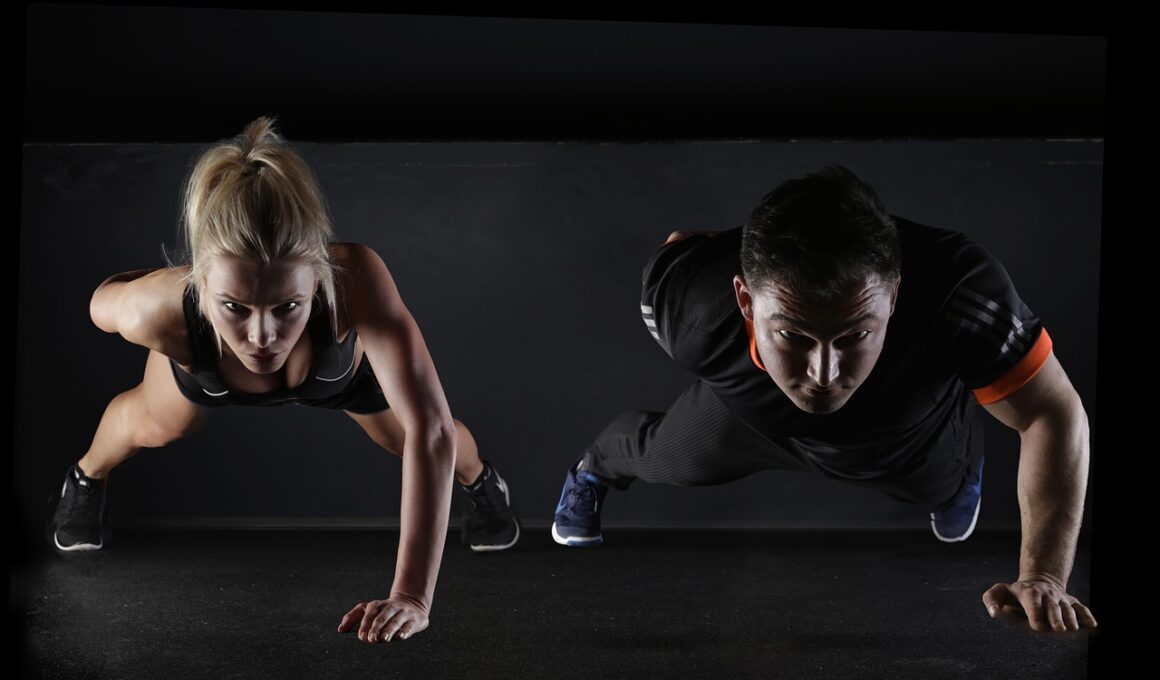No Gym Needed: Effective Strength Training Using Your Bodyweight
Bodyweight exercises are growing in popularity, not only for convenience but also for effectiveness. Using your body’s weight can lead to significant improvements in strength, endurance, and flexibility. These exercises can be performed anywhere, making them especially attractive to those who may not have access to a gym or prefer exercising outdoors. Incorporating bodyweight routines into your regimen can yield impressive results without the need for expensive equipment or a dedicated workout area. Whether you’re a beginner or an advanced athlete, bodyweight movements can challenge all fitness levels, adapting to your personal capabilities. It’s important to understand various exercises available that target different muscle groups, enhancing overall performance. Movements like push-ups and squats are just the tip of the iceberg, as many functional movements can be adapted to develop specific areas of strength. Additionally, many bodyweight routines are quite adaptable, allowing for increased difficulty as you progress. The principles of progressive overload still apply, as adding more repetitions, variations, or slowing down the tempo can intensify the exertion. With commitment and creativity, you can successfully build strength and improve fitness without stepping foot inside a gym.
Benefits of Bodyweight Training
One significant advantage of bodyweight training is its accessibility. No matter where you are, you can easily perform various exercises to get a full workout. This makes it especially appealing to busy individuals or those with a limited budget. Bodyweight exercises build strength, improve balance and coordination, and enhance flexibility. They work by utilizing gravity as resistance and can effectively enhance muscle engagement and function. These workouts engage multiple muscles at once, which can lead to better overall fitness and efficiency in movements. As you progress, you can increase the workout’s intensity by modifying the movements or integrating more complex variations. For instance, instead of regular push-ups, you can try one-arm variations or explosive plyometric versions. Bodyweight training not only boosts physical muscles but also mental resilience. Overcoming bodyweight-related challenges can dramatically improve self-esteem and confidence, unlocking a more positive outlook on fitness. You may also find satisfaction in mastering specific moves and achieving personal goals. As a minimalistic approach to fitness, bodyweight exercises require no costly equipment, opening up fitness opportunities that anyone can seize.
When beginning your bodyweight training journey, it’s crucial to build a solid foundation with proper techniques. Start with basic exercises like push-ups, squats, lunges, and planks. Focus on mastering these movements before progressing to more complex variations. This approach not only aids in preventing injury but also ensures that you build the required strength and stability. To enhance your workouts, consider incorporating different angles and speeds into each repetition. Varying your action stimulates muscle growth while also increasing overall burn, engaging fast-twitch muscle fibers. As you become comfortable with foundational movements, you should progressively introduce more exercises that challenge your body. For instance, transitioning from an incline push-up to a decline push-up or adding handstand variations can significantly elevate the intensity. Keep each session dynamic by altering your workout structure. You can organize workouts as circuits, intervals, or targeted muscle group focused. Staying intentional about the duration and intensity will maximize results. Always listen to your body, allowing adequate time for recovery. Incorporate rest days as necessary to give your muscles time to adapt, ensuring sustainable progress throughout your fitness journey.
Creating a Balanced Routine
Creating a balanced bodyweight training routine is essential for achieving your fitness goals sustainably. Aim to cover all major muscle groups, including the upper body, lower body, core, and mobility. Each session should incorporate exercises that target these areas to promote symmetry and prevent muscle imbalances. A good way to ensure this balance is to split your workout routines into different focusing days. For example, you might focus on upper body strength one day and lower body strength another. Combine this with core workouts to maintain functional stability. Consider adding dynamic stretching for warm-up and cool-down, which enhances flexibility and promotes overall mobility. Ensure to include push, pull, squat, and core stabilization movements in every workout cycle. You can create upper body days featuring push-ups, dips, and rows, and lower body sessions with squats, lunges, and bridges. Additionally, dedicating certain days to full-body exercises or high-intensity interval training (HIIT) is beneficial for conditioning. Scheduling workouts while balancing rest periods will lead to improved performance over time. Taking into account all these components makes developing an effective routine that advances strength training using bodyweight easier.
While consistency is key to seeing results, nutrition also plays a crucial role in your fitness journey. A balanced diet helps support your body’s recovery and repair processes after workouts. Make sure to incorporate plenty of protein, healthy fats, and complex carbohydrates into each meal to fuel your body appropriately. Eating whole foods ensures you’re receiving all necessary nutrients for muscle recovery after rigorous workouts. Omega-3 fatty acids found in fish or nuts and seeds can also assist in reducing inflammation, promoting overall bodily health. Hydration is equally crucial for optimal performance. Always drink plenty of water before, during, and after your workouts to maintain your energy levels and performance efficiency. Consider reducing processed sugars and empty calories, as they can hinder your fitness progress. Supplementing your nutrition with vitamins and minerals can further enhance your recovery and overall well-being, especially during intense training phases. You’ll boost energy levels and effectiveness during workouts by keeping your nutrition in check. Remember that bodyweight training, much like any other fitness regimen, works best when complemented with a healthy lifestyle. Prioritize sleep, stress management, and emotional well-being for overall success.
Tracking Progress and Setting Goals
Tracking your progress is vital for staying motivated as you progress through bodyweight training. Documentation allows you to see the improvements you’ve made over time, whether through enhanced strength or increased endurance. Set achievable, measurable goals and regularly evaluate your progress to maintain motivation. For instance, aiming to perform a specific number of repetitions in a given time period can provide tangible benchmarks. Reflecting on your accomplishments can create positive reinforcement, motivating you to push further. Consider maintaining a workout journal or utilizing fitness apps to track personal successes. Logging your routines helps identify the areas needing more focus, allowing you to fine-tune your sessions to achieve specific strengths. As you reach goals, don’t hesitate to set new ones that remain challenging without being unattainable. This approach ensures that you remain engaged without risking burnout. Establish both short-term and long-term objectives. Short-term goals might include mastering a new bodyweight exercise, while long-term goals could focus on overall strength improvements. Regularly assessing your achievements keeps motivation high, while persistence provides continuous progress toward your ultimate fitness aspirations.
In conclusion, bodyweight exercises provide an effective means of engaging in strength training without the need for gym memberships or expensive equipment. Embracing exercises like push-ups, squats, lunges, and planks can significantly improve overall fitness and strength levels. With dedication, creativity, and a commitment to consistency, anyone can master a successful home training routine tailored to personal needs. Finding the right methods to incorporate these movements into daily life can lead to remarkable gains in physical fitness and mental confidence. This method of training adapts to fit all levels of fitness, allowing you to grow with each workout. As mentioned, bodyweight workouts can be modified to present challenges that grow with you, continually reinforcing strength and stamina improvements. The convenience of performing workouts anywhere also makes them a sustainable choice for long-term fitness. Ultimately, it’s about consistency and the commitment to personal growth. By prioritizing training, nutrition, and recovery simultaneously, you’ll lay a strong foundation for lasting results. Bodyweight exercises offer endless opportunities for improvement and growth, so take action and start now!
Examples of Effective Bodyweight Exercises
Here are some examples of effective bodyweight exercises to incorporate into your routine. These movements can build functional strength while enhancing muscle tone and endurance. Begin with push-ups targeting your chest, shoulders, and arms. Variations like wide-grip or close-grip push-ups can focus on different muscle groups. Next, squats engage your quadriceps, hamstrings, and glutes. Mastering proper squat form is crucial. Lunges are another excellent way to work on leg strength and stability while promoting coordination. Plank variations, such as side or extended planks, develop core muscles and improve posture. To improve flexibility, consider movements like burpees and mountain climbers that raise your heart rate. Challenge yourself with more advanced exercises like handstand push-ups, pistol squats, or tuck jumps for added intensity. Incorporating different tempos can also elevate your workout, transitioning from slow, controlled reps to explosive bursts. Remember to include warm-up and cool-down activities for injury prevention. These exercise options can provide a diverse and effective workout, adaptable regardless of your experience level. By consistently integrating this array into your training, you will see enhanced results and overall fitness improvement.


